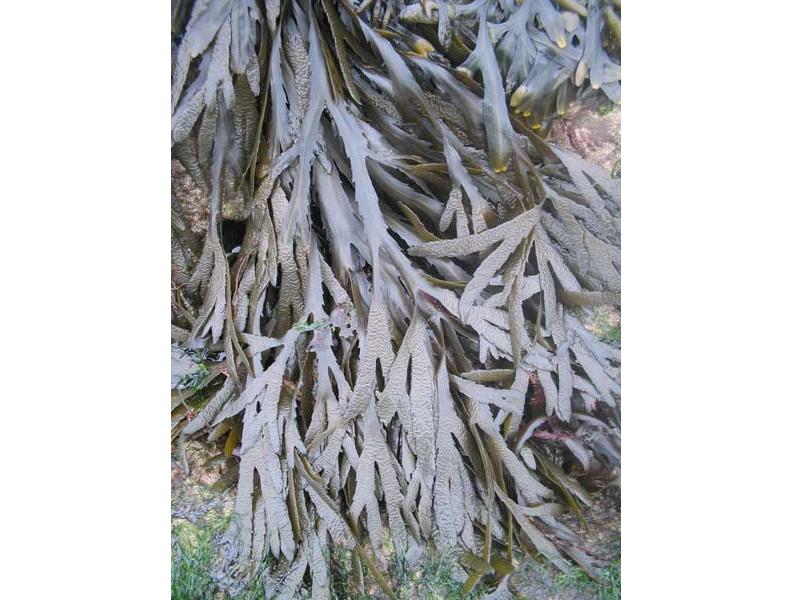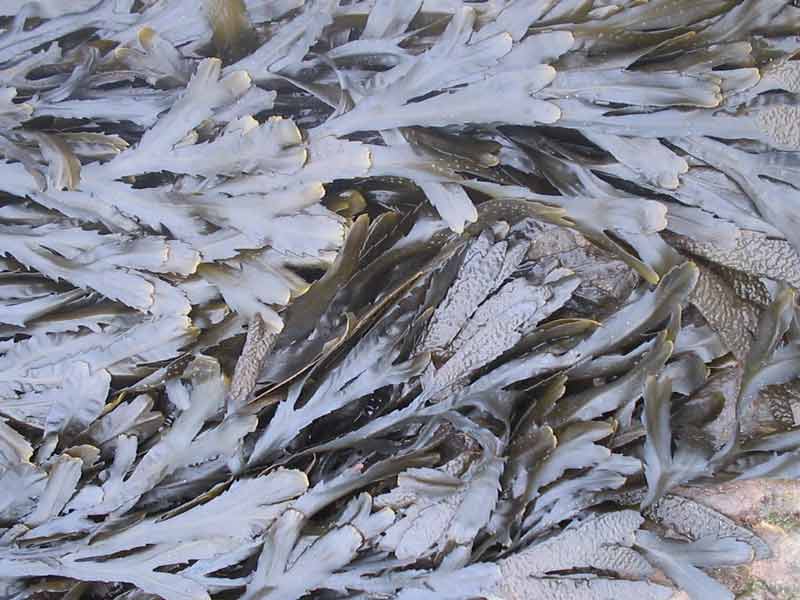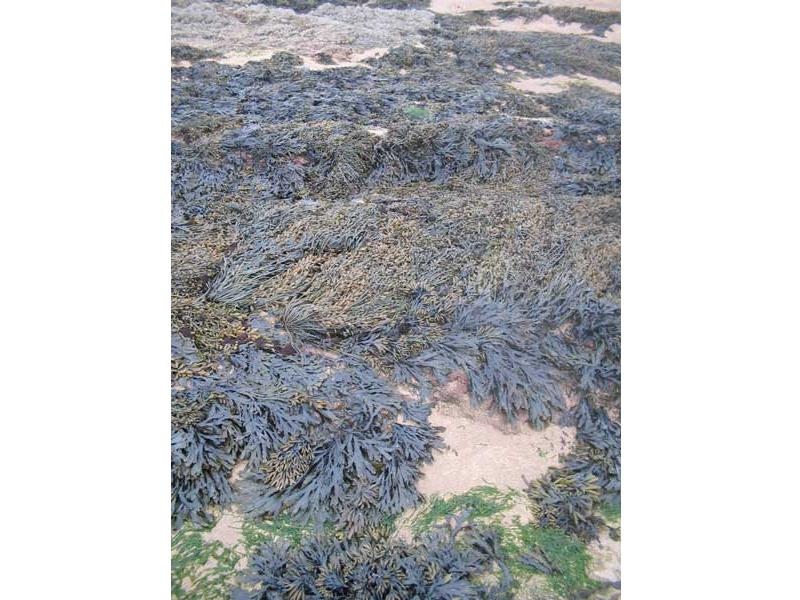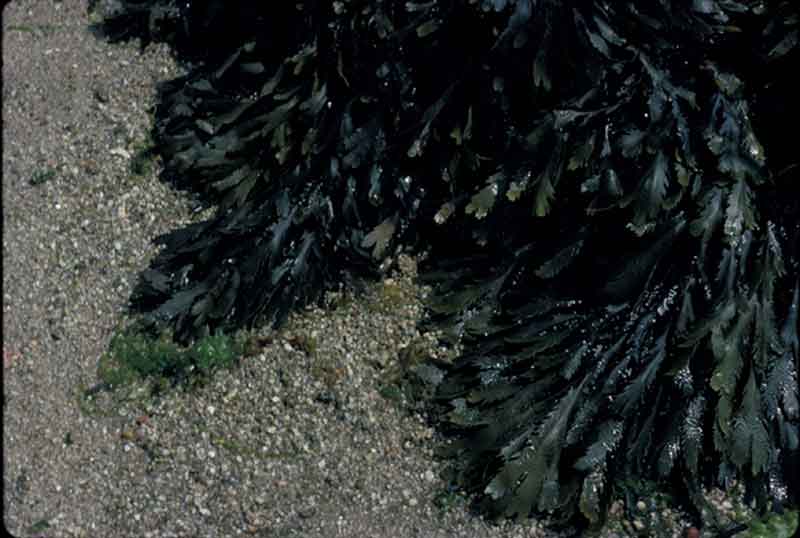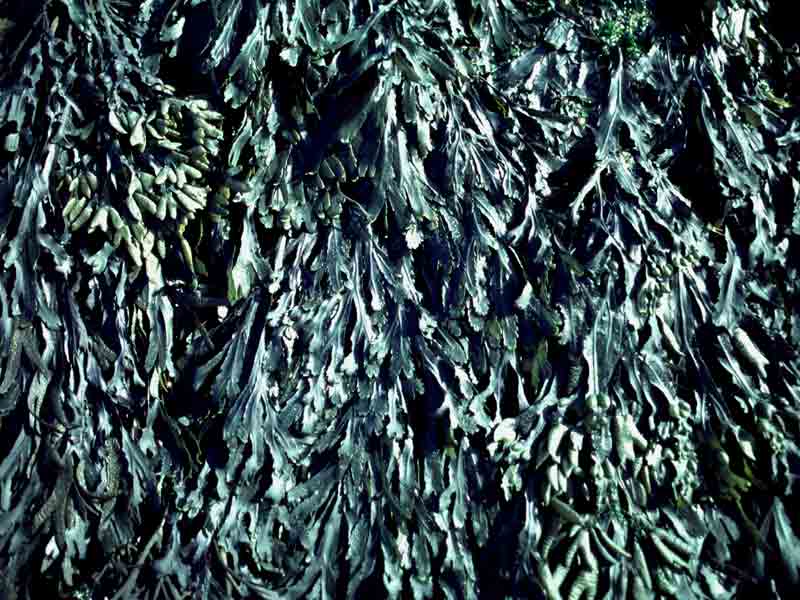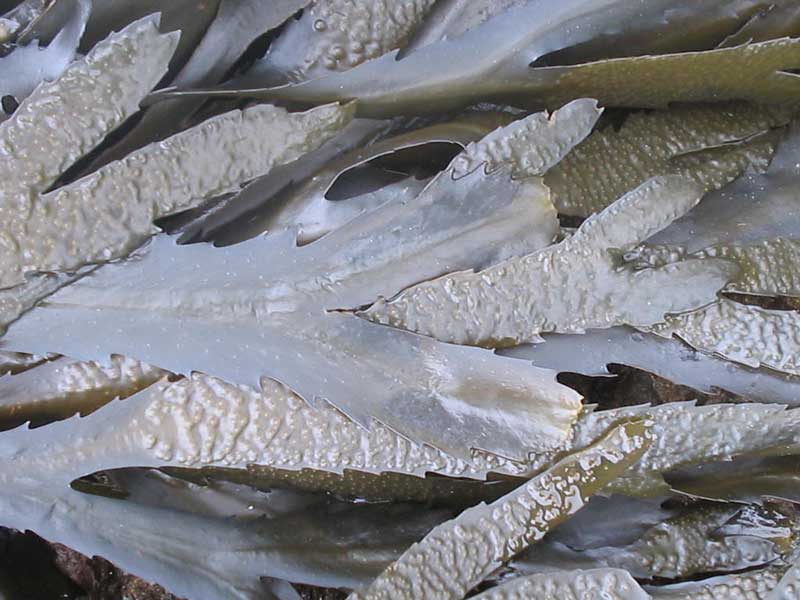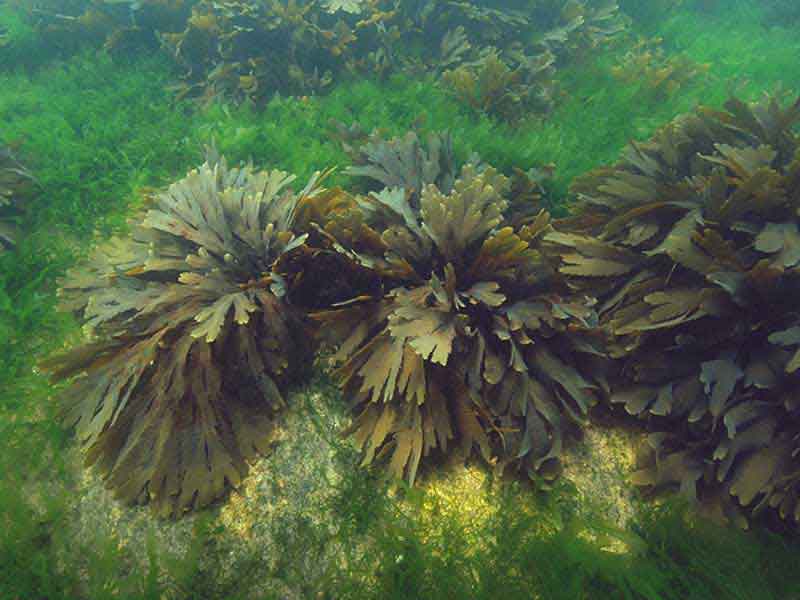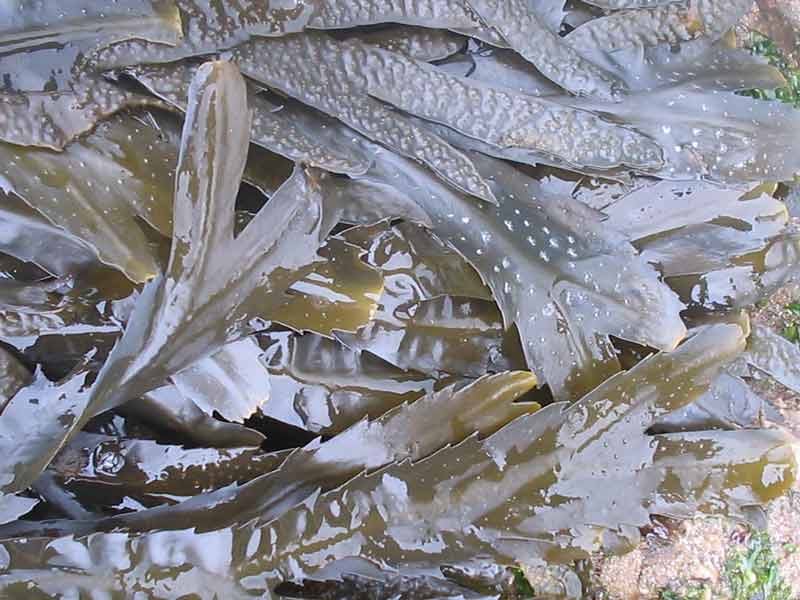Toothed wrack (Fucus serratus)
Distribution data supplied by the Ocean Biodiversity Information System (OBIS). To interrogate UK data visit the NBN Atlas.Map Help
| Researched by | Angus Jackson | Refereed by | Dr Graham Scott |
| Authority | Linnaeus, 1753 | ||
| Other common names | - | Synonyms | - |
Summary
Description
Fucus serratus, the toothed wrack, is a robust, olive-brown shrubby seaweed that grows in high densities low on the seashore. The fronds are about 2 cm wide, splitting in two repeatedly. The fronds bear no air bladders. The whole plant typically grows to about 60 cm long. The fronds have a serrated edge and grow from a short stalk.
Recorded distribution in Britain and Ireland
All British and Irish coasts.Global distribution
Northern Portugal and the Atlantic coast of France; British Isles, North Sea coasts and into the western Baltic; Scandinavia up to Novaya Zemlya; Iceland and the Gulf of St. Lawrence in the western north Atlantic.Habitat
Fucus serratus is found on hard substrata on the lower shore in more sheltered areas of coastline.Depth range
Not relevantIdentifying features
- Fronds are flat and straplike with a well developed mid-rib.
- Fronds edged with sharp, forward-pointing serrations.
- The frond bears no air bladders.
- The frond surface has numerous pin-pricks with clusters of tiny white hairs.
- Receptacles form slightly thickened patches about 4 cm long surrounded by a sterile border at the terminal end of the frond.
Additional information
Also known as serrated or saw wrack. Ripe male plants can be distinguished by their orange colour.
Listed by
- none -
Biology review
Taxonomy
| Level | Scientific name | Common name |
|---|---|---|
| Phylum | Ochrophyta | Brown and yellow-green seaweeds |
| Class | Phaeophyceae | |
| Order | Fucales | |
| Family | Fucaceae | |
| Genus | Fucus | |
| Authority | Linnaeus, 1753 | |
| Recent Synonyms | ||
Biology
| Parameter | Data | ||
|---|---|---|---|
| Typical abundance | High density | ||
| Male size range | 50-70cm | ||
| Male size at maturity | |||
| Female size range | Large(>50cm) | ||
| Female size at maturity | |||
| Growth form | Shrub | ||
| Growth rate | 0.2-0.1cm/day | ||
| Body flexibility | |||
| Mobility | Not relevant | ||
| Characteristic feeding method | Autotroph | ||
| Diet/food source | |||
| Typically feeds on | Not relevant | ||
| Sociability | No information | ||
| Environmental position | Epifloral | ||
| Dependency | Independent. | ||
| Supports | Substratum the hydroid, Dynamena pumila, the bryozoans Flustrellidra hispida, Alcyonidium hirsutum, Alcyonidium polyoum, Electra pilosa, and the polychaete Spirorbis spirorbis. | ||
| Is the species harmful? | No | ||
Biology information
During most of the year plant densities range between 10-14/0.25 square metres. When recruitment is occurring then densities may rise to 18-22/0.25 square metres. Surface cover by this species may reach over 95 percent during the summer. This decreases and becomes more patchy during winter and autumn. Fucus serratus typically grows up to 70 cm but has been recorded at over 2 m in length in very sheltered environments. Growth rate refers to maximal growth rate under optimal conditions. Growth rate varies considerably depending on environmental conditions. Growth rate ranges from 4-12 cm per annum. There are two size classes: germlings less than 10 cm (30-40 percent of the population); and adult plants greater than 40 cm. The germlings developing from eggs are initially microscopic and become visible to the naked eye after about two weeks. There is no clear mode in between but individuals of intermediate size are always present. Fucus serratus supports a wide variety of epiphytes with over 90 species having been recorded. Growth of microalgae on the frond surface can cause shading and reduced photosynthesis, anoxia at the frond surface and may interfere with reproduction. Mobile herbivores may benefit Fucus serratus through removal of this algal film. Other dominant macrofaunal species found on Fucus serratus include Lacuna pallidula, Littorina mariae, Amphithoe rubricata, Idotea granulosa and epiflora include Rhydomenia palmata and Elachista fucicola.
Habitat preferences
| Parameter | Data |
|---|---|
| Physiographic preferences | Open coast, Sea loch or Sea lough, Ria or Voe, Estuary |
| Biological zone preferences | |
| Substratum / habitat preferences | Bedrock, Cobbles, Large to very large boulders, Small boulders |
| Tidal strength preferences | Moderately strong 1 to 3 knots (0.5-1.5 m/sec.), Strong 3 to 6 knots (1.5-3 m/sec.), Very weak (negligible), Weak < 1 knot (<0.5 m/sec.) |
| Wave exposure preferences | Extremely sheltered, Moderately exposed, Sheltered, Very sheltered |
| Salinity preferences | Full (30-40 psu), Reduced (18-30 psu), Variable (18-40 psu) |
| Depth range | Not relevant |
| Other preferences | No text entered |
| Migration Pattern | Non-migratory or resident |
Habitat Information
Depth in metres is considered not relevant because the species is intertidal. More exposed coasts have a lower proportion of adult individuals in the population. In more sheltered areas Fucus serratus may grow on substrata such as cobbles.Life history
Adult characteristics
| Parameter | Data |
|---|---|
| Reproductive type | Gonochoristic (dioecious) |
| Reproductive frequency | Annual protracted |
| Fecundity (number of eggs) | >1,000,000 |
| Generation time | Insufficient information |
| Age at maturity | Insufficient information |
| Season | May - November |
| Life span | 2-5 years |
Larval characteristics
| Parameter | Data |
|---|---|
| Larval/propagule type | - |
| Larval/juvenile development | Not relevant |
| Duration of larval stage | No information |
| Larval dispersal potential | Greater than 10 km |
| Larval settlement period |
Life history information
Dickinson (1963) notes that fruiting fronds can be found almost throughout the year with fertile plants most in evidence during the winter months. However, most other work suggests that reproduction commences in late spring/early summer and continues through summer and autumn, peaking in August - October. Eggs and sperm are released into the water and fertilisation occurs in the water column. The eggs produce a sperm attractant called fucoserratin that is active within 0.5mm. The zygote then develops into a minute plant that can then settle onto the substratum. Post reproductive fronds are shed contributing to loss of surface cover. Many plants may be lost during winter due to storms and heavy wave action. Germlings have a high mortality, up to 83 % being recorded lost in 77 days on the Isle of Man. Reproduction occurs earlier and growth is faster on sheltered shores. Egg release is protracted. The largest number of receptacles recorded from a single plant is over 4,600. Eggs are broadcast into the water column to be carried by the current to settle and develop wherever they fall. Eggs attach firmly to the substratum within a few hours. Many eggs are eaten by browsing molluscs.
Sensitivity review
The MarLIN sensitivity assessment approach used below has been superseded by the MarESA (Marine Evidence-based Sensitivity Assessment) approach (see menu). The MarLIN approach was used for assessments from 1999-2010. The MarESA approach reflects the recent conservation imperatives and terminology and is used for sensitivity assessments from 2014 onwards.
Physical pressures
Use / to open/close text displayed
| Intolerance | Recoverability | Sensitivity | Evidence / Confidence | |
Substratum loss [Show more]Substratum lossBenchmark. All of the substratum occupied by the species or biotope under consideration is removed. A single event is assumed for sensitivity assessment. Once the activity or event has stopped (or between regular events) suitable substratum remains or is deposited. Species or community recovery assumes that the substratum within the habitat preferences of the original species or community is present. Further details EvidenceFucus serratus is permanently attached to the substratum. Fucus serratus is highly fecund, is iteroparous, surviving and breeding for protracted periods over 3-4 years. The eggs are broadcast into the water column allowing a potentially large dispersal distance. The species is found on all British and Irish coasts so there are few mechanisms isolating populations. If the entire population of Fucus serratus is removed, other species may come to dominate. Re-establishment of the seaweed may depend on the ability to out-compete other species and this may be dependent on suitable environmental conditions. | High | High | Moderate | High |
Smothering [Show more]SmotheringBenchmark. All of the population of a species or an area of a biotope is smothered by sediment to a depth of 5 cm above the substratum for one month. Impermeable materials, such as concrete, oil, or tar, are likely to have a greater effect. Further details. EvidenceIntolerance to smothering will depend on the state of the tide. If the factor occurs when the tide is out and the alga is lying flat on the substratum then all the frond will be covered and photosynthesis prevented. If smothering occurs whilst the alga is underwater and upright then not all the photosynthetic surfaces of adult plants will be covered. Germlings are likely to be smothered and killed and will be the most intolerant stage of Fucus serratus life history. A further form of smothering can occur through heavy growth of epibionts such as Flustrellidra hispida on the frond surfaces. This growth may reduce photosynthesis and increase anoxia at the frond surface. Fucus serratus is highly fecund, is iteroparous, surviving and breeding for protracted periods over 3-4 years. The eggs are broadcast into the water column allowing a potentially large dispersal distance. The species is found on all British and Irish coasts so there are few mechanisms isolating populations. If the entire population of Fucus serratus is removed, other species may come to dominate. Re-establishment of the seaweed may depend on the ability to outcompete other species and this may be dependent on suitable environmental conditions. | High | High | Moderate | Low |
Increase in suspended sediment [Show more]Increase in suspended sedimentBenchmark. An arbitrary short-term, acute change in background suspended sediment concentration e.g., a change of 100 mg/l for one month. The resultant light attenuation effects are addressed under turbidity, and the effects of rapid settling out of suspended sediment are addressed under smothering. Further details EvidenceSiltation will only have an effect during the time that the seaweed is covered with water. Increased siltation may cover the frond surface with a layer of sediment reducing photosynthesis and growth rate. Once conditions return to 'normal' then it probably won't take long for the population to resume a normal size and growth rate. | Low | Very high | Very Low | Low |
Decrease in suspended sediment [Show more]Decrease in suspended sedimentBenchmark. An arbitrary short-term, acute change in background suspended sediment concentration e.g., a change of 100 mg/l for one month. The resultant light attenuation effects are addressed under turbidity, and the effects of rapid settling out of suspended sediment are addressed under smothering. Further details Evidence | No information | |||
Desiccation [Show more]Desiccation
EvidenceSeaweeds cannot prevent desiccation, they can only tolerate it. Seaweeds have a critical water content. Desiccation past this point causes irreversible damage. The critical point for Fucus serratus is 40 percent water content. A reduction in water content to 40 percent can occur after 2 hours exposure to sunshine. Fucus spiralis, a similar species to Fucus serratus, transplanted further up the shore to the Pelvetia canaliculata zone (greater desiccation) die within 4-8 weeks (Schonbeck & Norton, 1978). Other species better able to tolerate desiccation will competitively displace Fucus serratus following increases in desiccation. Fucus serratus is highly fecund, is iteroparous, surviving and breeding for protracted periods over 3-4 years. The eggs are broadcast into the water column allowing a potentially large dispersal distance. The species is found on all British and Irish coasts so there are few mechanisms isolating populations. If the entire population of Fucus serratus is removed, other species may come to dominate. Re-establishment of the seaweed may depend on the ability to outcompete other species and this may be dependent on suitable environmental conditions. | Intermediate | High | Low | High |
Increase in emergence regime [Show more]Increase in emergence regimeBenchmark. A one hour change in the time covered or not covered by the sea for a period of one year. Further details EvidenceFucus spiralis, a similar species to Fucus serratus, transplanted further up the shore to the Pelvetia canaliculata zone (longer emergence) die within 4-8 weeks. Other species better able to tolerate desiccation will competitively displace Fucus serratus following increases in emergence. Decreases in emergence will put the species in competition with species that typically remain submerged (e.g. laminarians) although in some locations of reduced salinity (the Belt Sea) the Fucus serratus population remains continually submerged. Fucus serratus is highly fecund, is iteroparous, surviving and breeding for protracted periods over 3-4 years. The eggs are broadcast into the water column allowing a potentially large dispersal distance. The species is found on all British and Irish coasts so there are few mechanisms isolating populations. If the entire population of Fucus serratus is removed, other species may come to dominate. Re-establishment of the seaweed may depend on the ability to outcompete other species and this may be dependent on suitable environmental conditions. | Intermediate | High | Low | Moderate |
Decrease in emergence regime [Show more]Decrease in emergence regimeBenchmark. A one hour change in the time covered or not covered by the sea for a period of one year. Further details Evidence | No information | |||
Increase in water flow rate [Show more]Increase in water flow rateA change of two categories in water flow rate (view glossary) for 1 year, for example, from moderately strong (1-3 knots) to very weak (negligible). Further details EvidenceIncreases in water flow rate may cause some of the population to be torn off the substratum. Decreases in water flow rate are unlikely to have any effect. Fucus serratus is highly fecund, is iteroparous, surviving and breeding for protracted periods over 3-4 years. The eggs are broadcast into the water column allowing a potentially large dispersal distance. The species is found on all British and Irish coasts so there are few mechanisms isolating populations. Recruitment may occur through reproduction of the remaining population or from other populations. As some of the population remains it is unlikely that other species will come to dominate. Removal of some of the adult canopy will allow the understorey germling back to grow faster. Recovery will probably have occurred after a year. | Intermediate | High | Low | Moderate |
Decrease in water flow rate [Show more]Decrease in water flow rateA change of two categories in water flow rate (view glossary) for 1 year, for example, from moderately strong (1-3 knots) to very weak (negligible). Further details Evidence | No information | |||
Increase in temperature [Show more]Increase in temperature
For intertidal species or communities, the range of temperatures includes the air temperature regime for that species or community. Further details EvidenceDecreases in temperature are unlikely to have any effect. The species distribution extends north to Novaya Zemlya where water temperatures are much colder. Fucus distichus, a similar species can survive for several months at -40 °C. The species distribution also extends further south than the British Isles into warmer waters. Increases of up to 5°C above British and Irish temperatures is not likely to have a detrimental effect. Growth of Fucus serratus is optimal at 20 °C so British and Irish populations are more likely to benefit from increases in temperature. Fucus serratus cannot survive continual exposure to temperatures above 28°C for a week. | Tolerant | Not relevant | Not sensitive | High |
Decrease in temperature [Show more]Decrease in temperature
For intertidal species or communities, the range of temperatures includes the air temperature regime for that species or community. Further details Evidence | No information | |||
Increase in turbidity [Show more]Increase in turbidity
EvidenceTurbidity is only relevant when Fucus serratus is covered with water. Seaweed photosynthesis declines on emersion and recommences when recovered with water. Once conditions return to 'normal' then it will probably not take long for the population to resume a normal size and growth rate. | Low | Very high | Very Low | Moderate |
Decrease in turbidity [Show more]Decrease in turbidity
Evidence | No information | |||
Increase in wave exposure [Show more]Increase in wave exposureA change of two ranks on the wave exposure scale (view glossary) e.g., from Exposed to Extremely exposed for a period of one year. Further details EvidenceFucus serratus only occurs on coasts with moderate exposure or less. Increases above this level of wave action will cause damage to individual plants, breaking fronds and removing entire plants from the substratum. Fucus serratus is more intolerant of wave exposure than Fucus vesiculosus. On more exposed coasts there are fewer adult individuals in the population. Fucus serratus is highly fecund, is iteroparous, surviving and breeding for protracted periods over 3-4 years. The eggs are broadcast into the water column allowing a potentially large dispersal distance. The species is found on all British and Irish coasts so there are few mechanisms isolating populations. If the entire population of Fucus serratus is removed, other species may come to dominate. Re-establishment of the seaweed may depend on the ability to outcompete other species and this may be dependent on suitable environmental conditions. | High | High | Moderate | Moderate |
Decrease in wave exposure [Show more]Decrease in wave exposureA change of two ranks on the wave exposure scale (view glossary) e.g., from Exposed to Extremely exposed for a period of one year. Further details Evidence | No information | |||
Noise [Show more]Noise
EvidenceSeaweeds have no known mechanism for detection of noise vibrations. | Tolerant | Not relevant | Not sensitive | High |
Visual presence [Show more]Visual presenceBenchmark. The continuous presence for one month of moving objects not naturally found in the marine environment (e.g., boats, machinery, and humans) within the visual envelope of the species or community under consideration. Further details EvidenceSeaweeds have no known mechanism for visual perception. | Tolerant | Not relevant | Not sensitive | High |
Abrasion & physical disturbance [Show more]Abrasion & physical disturbanceBenchmark. Force equivalent to a standard scallop dredge landing on or being dragged across the organism. A single event is assumed for assessment. This factor includes mechanical interference, crushing, physical blows against, or rubbing and erosion of the organism or habitat of interest. Where trampling is relevant, the evidence and trampling intensity will be reported in the rationale. Further details. EvidenceAlthough the species is highly flexible, abrasion is likely to cause damage to and removal of fronds and even removal of entire plants from the substratum. Human trampling has been shown to significantly reduce the cover of fucoids on a shore (Holt et al., 1997) Cracks and crevices are ideal places for germlings to develop and these sites may be protected from abrasion. Fucus serratus is highly fecund, is iteroparous, surviving and breeding for protracted periods over 3-4 years. The eggs are broadcast into the water column allowing a potentially large dispersal distance. The species is found on all British and Irish coasts so there are few mechanisms isolating populations. Recruitment may occur through reproduction of the remaining population of from other populations. As some of the population remains it is unlikely that other species will come to dominate. Removal of some of the adult canopy will allow the understorey germling back to grow faster. Recovery will probably have occurred after a year. | Intermediate | High | Low | High |
Displacement [Show more]DisplacementBenchmark. Removal of the organism from the substratum and displacement from its original position onto a suitable substratum. A single event is assumed for assessment. Further details EvidenceFucus serratus is permanently attached to the substratum. If removed, the attachment cannot be reformed. Fucus serratus is highly fecund, is iteroparous, surviving and breeding for protracted periods over 3-4 years. The eggs are broadcast into the water column allowing a potentially large dispersal distance. The species is found on all British and Irish coasts so there are few mechanisms isolating populations. If the entire population of Fucus serratus is removed, other species may come to dominate. Re-establishment of the seaweed may depend on the ability to out-compete other species and this may be dependent on suitable environmental conditions. | High | High | Moderate | High |
Chemical pressures
Use [show more] / [show less] to open/close text displayed
| Intolerance | Recoverability | Sensitivity | Evidence / Confidence | |
Synthetic compound contamination [Show more]Synthetic compound contaminationSensitivity is assessed against the available evidence for the effects of contaminants on the species (or closely related species at low confidence) or community of interest. For example:
The evidence used is stated in the rationale. Where the assessment can be based on a known activity then this is stated. The tolerance to contaminants of species of interest will be included in the rationale when available; together with relevant supporting material. Further details. EvidenceDifferent life stages of Fucus serratus differ in their intolerance to synthetic chemicals. Scalan & Wilkinson (1987) found that spematozoa and newly fertilized eggs of Fucus serratus were the most intolerant of biocides, while adult plants were only just significantly affected at 5 ml/l of the biocides Dodigen v181-1, Dodigen v 2861-1 and ML-910. Fucus serratus is highly fecund, is iteroparous, surviving and breeding for protracted periods over 3-4 years. The eggs are broadcast into the water column allowing a potentially large dispersal distance. The species is found on all British and Irish coasts so there are few mechanisms isolating populations. If the entire population of Fucus serratus is removed, other species may come to dominate. Re-establishment of the seaweed may depend on the ability to outcompete other species and this may be dependent on suitable environmental conditions. | High | High | Moderate | Not relevant |
Heavy metal contamination [Show more]Heavy metal contaminationEvidenceFucoid algae readily accumulate heavy metals within their tissues. The effect of heavy metals on the growth rate of adult Fucus serratus plants has been studied by Stromgren (1979b;1980a & b). Copper significantly reduces the growth rate of vegetative apices at 25 µg/l over 10 days (Stromgren, 1979b). Zinc, lead, cadmium & mercury significantly reduce growth rate at 1400 µg/l , 810ug/l, 450ug/l and 5ug/l respectively (Stromgren, 1980a & b). The benchmark concentrations of heavy metals may therefore reduce growth rate, so intolerance is reported as low, although early life stages of the species may be more intolerant. | Low | High | Low | Not relevant |
Hydrocarbon contamination [Show more]Hydrocarbon contaminationEvidenceAdult plants are tolerant of exposure to spills of crude oil although very young germlings are intolerant of relatively low concentrations of 'water soluble' extractions of crude oils. Exposure of eggs to these extractions (at 1.5 micrograms/ml for 96 hours) interferes with adhesion during settling) and (at 0.1micrograms/ml) prevents further development (Johnston, 1977). Fucus serratus is highly fecund, is iteroparous, surviving and breeding for protracted periods over 3-4 years. The eggs are broadcast into the water column allowing a potentially large dispersal distance. The species is found on all British and Irish coasts so there are few mechanisms isolating populations. Recruitment may occur through reproduction of the remaining population or from other populations. As some of the population remains it is unlikely that other species will come to dominate. Removal of some of the adult canopy will allow the understorey germling back to grow faster. Recovery will probably have occurred after a year. | Intermediate | High | Low | High |
Radionuclide contamination [Show more]Radionuclide contaminationEvidenceInsufficientinformation | No information | No information | No information | Not relevant |
Changes in nutrient levels [Show more]Changes in nutrient levelsEvidenceWhen in high densities, the seaweed competes for space light and nutrients. Nutrient availability is the most important factor controlling germling growth. Plants under low nutrient regimes achieve smaller sizes and may be out competed. Fucus serratus is highly fecund, is iteroparous, surviving and breeding for protracted periods over 3-4 years. The eggs are broadcast into the water column allowing a potentially large dispersal distance. The species is found on all British and Irish coasts so there are few mechanisms isolating populations. Recruitment may occur through reproduction of the remaining population of from other populations. As some of the population remains it is unlikely that other species will come to dominate. Removal of some of the adult canopy will allow the understorey germling back to grow faster. Recovery will probably have occurred after a year. | Intermediate | High | Low | Moderate |
Increase in salinity [Show more]Increase in salinity
EvidenceBeing intertidal and subject to precipitation, Fucus serratus is exposed to a range of salinities. The species is able to compensate for these changes in salinity by adjusting internal ion concentrations. Salinity affects the photosynthetic rate and hence growth rate of seaweed. For Fucus serratus, growth rate is maximal at a salinity of 20 psu. Above and below this growth rate declines. If salinity is suddenly increased for brief periods then the rate of net photosynthesis increases before decreasing. Salinity can also affect respiration rates. Once conditions return to 'normal' then it probably won't take long for the population to resume a normal size and growth rate. | Low | Very high | Very Low | High |
Decrease in salinity [Show more]Decrease in salinity
Evidence | No information | |||
Changes in oxygenation [Show more]Changes in oxygenationBenchmark. Exposure to a dissolved oxygen concentration of 2 mg/l for one week. Further details. EvidenceCole et al. (1999) suggest possible adverse effects on marine species below 4 mg/l and probable adverse effects below 2mg/l. There is no information about Fucus serratus tolerance to changes in oxygenation. Once conditions return to 'normal' then it probably won't take long for the population to resume a normal size and growth rate. | Low | Very high | Very Low | Low |
Biological pressures
Use [show more] / [show less] to open/close text displayed
| Intolerance | Recoverability | Sensitivity | Evidence / Confidence | |
Introduction of microbial pathogens/parasites [Show more]Introduction of microbial pathogens/parasitesBenchmark. Sensitivity can only be assessed relative to a known, named disease, likely to cause partial loss of a species population or community. Further details. EvidenceInsufficientinformation | No information | No information | No information | Not relevant |
Introduction of non-native species [Show more]Introduction of non-native speciesSensitivity assessed against the likely effect of the introduction of alien or non-native species in Britain or Ireland. Further details. EvidenceInsufficientinformation | No information | No information | No information | Not relevant |
Extraction of this species [Show more]Extraction of this speciesBenchmark. Extraction removes 50% of the species or community from the area under consideration. Sensitivity will be assessed as 'intermediate'. The habitat remains intact or recovers rapidly. Any effects of the extraction process on the habitat itself are addressed under other factors, e.g. displacement, abrasion and physical disturbance, and substratum loss. Further details. EvidenceFucus serratus is one of several harvested and exploited algal species. Fucus serratus is highly fecund, is iteroparous, surviving and breeding for protracted periods over 3-4 years. The eggs are broadcast into the water column allowing a potentially large dispersal distance. The species is found on all British and Irish coasts so there are few mechanisms isolating populations. Recruitment may occur through reproduction of the remaining population of from other populations. As some of the population remains it is unlikely that other species will come to dominate. Removal of some of the adult canopy will allow the understorey germling back to grow faster. Recovery will probably have occurred after a year. | Intermediate | High | Low | High |
Extraction of other species [Show more]Extraction of other speciesBenchmark. A species that is a required host or prey for the species under consideration (and assuming that no alternative host exists) or a keystone species in a biotope is removed. Any effects of the extraction process on the habitat itself are addressed under other factors, e.g. displacement, abrasion and physical disturbance, and substratum loss. Further details. EvidenceFucus serratus has no known obligate relationships. | Tolerant | Not relevant | Not sensitive | Low |
Additional information
Importance review
Policy/legislation
- no data -
Status
| National (GB) importance | - | Global red list (IUCN) category | - |
Non-native
| Parameter | Data |
|---|---|
| Native | - |
| Origin | - |
| Date Arrived | - |
Importance information
The seaweed is collected, dried and used as a soil additive. Various fucalean algae are used in the production of alginates. These are used widely in the pharmaceutical and cosmetics industries. The dense beds of Fucus serratus provide shelter for a very wide variety of species and also provide considerable substratum for epiphytic species. National status for Fucus serratus is not available but is almost certainly widespread.Bibliography
Brenchley, J.L., Rava, J.A. & Johnston, A.M., 1997. Resource acquisition in two intertidal fucoid seaweeds, Fucus serratus and Himanthalia elongata: seasonal variation and effects of reproductive development. Marine Biology, 129, 367-375.
Creed, J.C., Norton, T.A. & Kain, J.M., 1997. Intraspecific competition in Fucus serratus germlings: The interaction of light, nutrients and density. Journal of Experimental Marine Biology and Ecology, 212, 211-223.
Dickinson, C.I., 1963. British seaweeds. London & Frome: Butler & Tanner Ltd.
Hayward, P., Nelson-Smith, T. & Shields, C. 1996. Collins pocket guide. Sea shore of Britain and northern Europe. London: HarperCollins.
Howson, C.M. & Picton, B.E., 1997. The species directory of the marine fauna and flora of the British Isles and surrounding seas. Belfast: Ulster Museum. [Ulster Museum publication, no. 276.]
Johnston, C.S., 1977. The sub-lethal effects of water-soluble extracts of oil on the fertilisation and development of Fucus serratus L. (Serrated wrack). Rapports et Proces Verbaux des Reunions. Conseil International pour l'Exploration de la Mer, 171, 184-185.
Knight, M. & Parke, M., 1950. A biological study of Fucus vesiculosus L. and Fucus serratus L. Journal of the Marine Biological Association of the United Kingdom, 29, 439-514.
Lobban, C.S. & Harrison, P.J., 1997. Seaweed ecology and physiology. Cambridge: Cambridge University Press.
Scanlan, C.M. & Wilkinson, M., 1987. The use of seaweeds in biocide toxicity testing. Part 1. The sensitivity of different stages in the life-history of Fucus and of other algae, to certain biocides. Marine Environmental Research, 21, 11-29.
Schonbeck, M.W. & Norton, T.A., 1978. Factors controlling the upper limits of fucoid algae on the shore. Journal of Experimental Marine Biology and Ecology, 31, 303-313.
Seed, R. & O'Connor, R.J., 1981. Epifaunal associates of Fucus serratus at Dale, south-west Wales. Holarctic Ecology, 4, 1-11.
Strömgren, T., 1979b. The effect of zinc on the increase in length of five species of intertidal Fucales. Journal of Experimental Marine Biology and Ecology, 40, 95-102.
Strömgren, T., 1980a. The effect of dissolved copper on the increase in length of four species of intertidal fucoid algae. Marine Environmental Research, 3, 5-13.
Strömgren, T., 1980b. The effect of lead, cadmium and mercury on the increase in length of five intertidal Fucales. Journal of Experimental Marine Biology and Ecology, 43, 107-119.
Williams, G.A., 1996. Seasonal variation in a low shore Fucus serratus (Fucales, Phaeophyta) population and its epiphytic fauna. Hydrobiologia, 326/327, 191-197.
Datasets
Bristol Regional Environmental Records Centre, 2017. BRERC species records recorded over 15 years ago. Occurrence dataset: https://doi.org/10.15468/h1ln5p accessed via GBIF.org on 2018-09-25.
Bristol Regional Environmental Records Centre, 2017. BRERC species records within last 15 years. Occurrence dataset: https://doi.org/10.15468/vntgox accessed via GBIF.org on 2018-09-25.
Centre for Environmental Data and Recording, 2018. Ulster Museum Marine Surveys of Northern Ireland Coastal Waters. Occurrence dataset https://www.nmni.com/CEDaR/CEDaR-Centre-for-Environmental-Data-and-Recording.aspx accessed via NBNAtlas.org on 2018-09-25.
Cofnod – North Wales Environmental Information Service, 2018. Miscellaneous records held on the Cofnod database. Occurrence dataset: https://doi.org/10.15468/hcgqsi accessed via GBIF.org on 2018-09-25.
Environmental Records Information Centre North East, 2018. ERIC NE Combined dataset to 2017. Occurrence dataset: http://www.ericnortheast.org.ukl accessed via NBNAtlas.org on 2018-09-38
Fenwick, 2018. Aphotomarine. Occurrence dataset http://www.aphotomarine.com/index.html Accessed via NBNAtlas.org on 2018-10-01
Fife Nature Records Centre, 2018. St Andrews BioBlitz 2014. Occurrence dataset: https://doi.org/10.15468/erweal accessed via GBIF.org on 2018-09-27.
Fife Nature Records Centre, 2018. St Andrews BioBlitz 2015. Occurrence dataset: https://doi.org/10.15468/xtrbvy accessed via GBIF.org on 2018-09-27.
Fife Nature Records Centre, 2018. St Andrews BioBlitz 2016. Occurrence dataset: https://doi.org/10.15468/146yiz accessed via GBIF.org on 2018-09-27.
Kent Wildlife Trust, 2018. Biological survey of the intertidal chalk reefs between Folkestone Warren and Kingsdown, Kent 2009-2011. Occurrence dataset: https://www.kentwildlifetrust.org.uk/ accessed via NBNAtlas.org on 2018-10-01.
Kent Wildlife Trust, 2018. Kent Wildlife Trust Shoresearch Intertidal Survey 2004 onwards. Occurrence dataset: https://www.kentwildlifetrust.org.uk/ accessed via NBNAtlas.org on 2018-10-01.
Lancashire Environment Record Network, 2018. LERN Records. Occurrence dataset: https://doi.org/10.15468/esxc9a accessed via GBIF.org on 2018-10-01.
Manx Biological Recording Partnership, 2017. Isle of Man wildlife records from 01/01/2000 to 13/02/2017. Occurrence dataset: https://doi.org/10.15468/mopwow accessed via GBIF.org on 2018-10-01.
Manx Biological Recording Partnership, 2018. Isle of Man historical wildlife records 1990 to 1994. Occurrence dataset: https://doi.org/10.15468/aru16v accessed via GBIF.org on 2018-10-01.
Manx Biological Recording Partnership, 2018. Isle of Man historical wildlife records 1995 to 1999. Occurrence dataset: https://doi.org/10.15468/lo2tge accessed via GBIF.org on 2018-10-01.
Merseyside BioBank., 2018. Merseyside BioBank (unverified). Occurrence dataset: https://doi.org/10.15468/iou2ld accessed via GBIF.org on 2018-10-01.
National Trust, 2017. National Trust Species Records. Occurrence dataset: https://doi.org/10.15468/opc6g1 accessed via GBIF.org on 2018-10-01.
NBN (National Biodiversity Network) Atlas. Available from: https://www.nbnatlas.org.
OBIS (Ocean Biodiversity Information System), 2025. Global map of species distribution using gridded data. Available from: Ocean Biogeographic Information System. www.iobis.org. Accessed: 2025-05-11
Outer Hebrides Biological Recording, 2018. Non-vascular Plants, Outer Hebrides. Occurrence dataset: https://doi.org/10.15468/goidos accessed via GBIF.org on 2018-10-01.
Royal Botanic Garden Edinburgh, 2018. Royal Botanic Garden Edinburgh Herbarium (E). Occurrence dataset: https://doi.org/10.15468/ypoair accessed via GBIF.org on 2018-10-02.
South East Wales Biodiversity Records Centre, 2018. SEWBReC Algae and allied species (South East Wales). Occurrence dataset: https://doi.org/10.15468/55albd accessed via GBIF.org on 2018-10-02.
South East Wales Biodiversity Records Centre, 2018. Dr Mary Gillham Archive Project. Occurance dataset: http://www.sewbrec.org.uk/ accessed via NBNAtlas.org on 2018-10-02
Suffolk Biodiversity Information Service., 2017. Suffolk Biodiversity Information Service (SBIS) Dataset. Occurrence dataset: https://doi.org/10.15468/ab4vwo accessed via GBIF.org on 2018-10-02.
The Wildlife Information Centre, 2018. TWIC Biodiversity Field Trip Data (1995-present). Occurrence dataset: https://doi.org/10.15468/ljc0ke accessed via GBIF.org on 2018-10-02.
Yorkshire Wildlife Trust, 2018. Yorkshire Wildlife Trust Shoresearch. Occurrence dataset: https://doi.org/10.15468/1nw3ch accessed via GBIF.org on 2018-10-02.
Citation
This review can be cited as:
Last Updated: 29/05/2008

